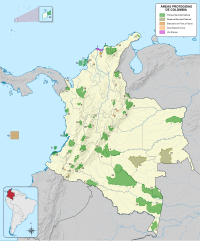Sierra Nevada del Cocuy
Since 1977, this region is protected within a National Natural Park (NNP-Cocuy) because of its fragile páramos, extraordinary bio-diversity and endemism, and its function as a corridor for migratory species under conditions of climate change.
The Sierra Nevada del Cocuy is also the largest glacial mass in Colombia, and meltwater from this glacier system feed the rivers Arauca, Casanare and Chicamocha,[2] which in turn drain into the Magdalena and Orinoco basins.
In general, the geology of the Sierra Nevada del Cocuy consists on sedimentary rocks from the Cretaceous, broadly made up of sequences of quartzites, sandstones and fine-grained mudstones of Aptian and Cenomanian ages.
[11] These are high mountain (3000 – 4800 masl) tundra ecosystems characteristic of the tropical South American Andes and only occur in Costa Rica, Panamá, Colombia, Venezuela, Ecuador and Perú.
[14] One of the most characteristic plants of the páramo ecosystem, widely spread within the Sierra Nevada del Cocuy, is the yellow-flowered Frailejón (Espeletia lopezii), which dominates the landscapes below the ice line, although many others, belonging to the Compositae, Lamiceae, Poceae and Rosaceae families can be found.
[10] In spite of their ecological uniqueness, their importance for human sustenance and their inhospitable climatic and geographic conditions, the páramo systems in the Cocuy region have suffered environmental impacts, caused by many different parties.
It has been demonstrated that unsustainable land use, combined with the effects of climate change affect the natural populations of useful endemic plants (mostly medicinal), especially in the western slope of the Sierra Nevada del Cocuy.
[10] For example, the steep walls of the glacial U-shaped valleys are made up mostly of quartzitic sandstones and shales, which leads to fragile slope failure and rock falls.
[10] Nevertheless, glacial geomorphological features are pervasive such as terminal and lateral moraines, cirques, U-shaped valleys, proglacial, marginal and supraglacial lakes and ice caps.
[20] With the onset of accelerated warming due to anthropogenic climate change, tropical glaciers such as the ones on the Sierra Nevada del Cocuy are bound to disappear in the next few decades.
The Sierra Nevada del Cocuy glaciers, which used to be a single ice body only a few decades ago, had lost an estimated 35-45% of its glacial area in only 15 years (measured in 2006).



